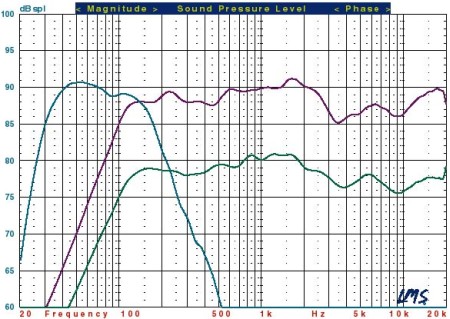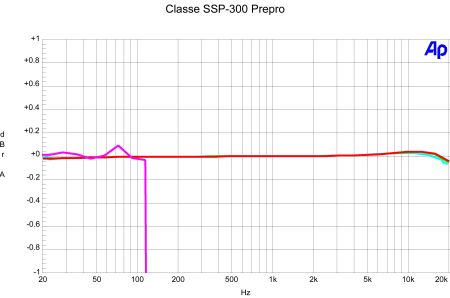caressing competitions?skyhook counters trembling fluctuating protection
Missing Measurements
HT Labs Measures: JBL Cinema Sound Speaker System

Satellite Sensitivity:
90 dB from 500 Hz to 2 kHz
Center Sensitivity:
89.5 dB from 500 Hz to 2 kHz
This graph shows the quasi-anechoic (employing close-miking of all woofers) frequency response of the CST55 satellites (purple trace), CSS10 subwoofer (blue trace), and CSC55 center channel (green trace). All passive loudspeakers were measured with grills at a distance of 1 meter with a 2.83-volt input and scaled for display purposes.
The CST55’s listening-window response (a five-point average of axial and +/-15-degree horizontal and vertical responses) measures +1.16/-4.84 decibels from 200 hertz to 10 kilohertz. The -3dB point is at 111 Hz, and the -6dB point is at 95 Hz. Impedance reaches a minimum of 4.99 ohms at 708 Hz and a phase angle of -38.48 degrees at 136 Hz.
The CSC55’s listening-window response measures +1.44/-3.92 dB from 200 Hz to 10 kHz. An average of axial and +/-15-degree horizontal responses measures +1.27/-4.26 dB from 200 Hz to 10 kHz. The -3dB point is at 108 Hz, and the -6dB point is at 92 Hz. Impedance reaches a minimum of 5.53 ohms at 244 Hz and a phase angle of -58.31 degrees at 132 Hz.
The CSS10’s close-miked response, normalized to the level at 80 Hz, indicates that the lower -3dB point is at 32 Hz and the -6dB point is at 29 Hz. The upper -3dB point is at 162 Hz using the LFE input. -MJP
HT Labs Measures: Cambridge SurroundWorks 200 HTIB

This graph shows the quasi-anechoic (employing close-miking of all woofers) frequency response of the Surround Works 200 satellite (purple trace) and matching subwoofer (blue trace). The passive loudspeaker was measured with grill at a distance of 1 meter with a 2.83-volt input and scaled for display purposes. Please note that the proprietary connectors on this system precluded performing many of our usual tests.
The satellite's listening-window response (a five-point average of axial and +/-15-degree horizontal and vertical responses) measures +0.93/-6.12 decibels from 200 hertz to 10 kilohertz. The -3dB point is at 143 Hz, and the -6dB point is at 129 Hz.
The sub's close-miked response, normalized to the level at 80 Hz, indicates that the lower -3dB point is at 33 Hz and the -6dB point is at 31 Hz. The upper -3dB point is at 156 Hz.-MJP
HT Labs Measures: Classe SSP-300 Pre/Pro

Analog frequency response in Stereo 24/96 mode:
-0.29 dB at 10 Hz
-0.08 dB at 20 Hz
-0.12 dB at 20 kHz
-20.02 dB at 50 kHz.
Analog frequency response with signal processing:
-0.17 dB at 10 Hz
-0.06 dB at 20 Hz
-0.15 dB at 20 kHz
-50.40 dB at 50 kHz.
The above chart shows the frequency response of the left (blue), center (green), LFE (purple), and left surround (red) channels at the preamp outputs of the Dolby Digital decoder. The left channel measures -0.01 decibels at 20 hertz and -0.03 dB at 20 kilohertz. The center channel measures -0.03 dB at 20 Hz and -0.05 dB at 20 kHz, and the left surround channel measures -0.02 dB at 20 Hz and -0.04 dB at 20 kHz. The LFE channel, normalized to the level at 40 Hz, is +0.01dB at 20 Hz, reaches the upper -3dB point at 118 Hz, and reaches the upper -6dB point at 122 Hz.
Response from the multichannel input to the main output measures -0.11 dB at 10 Hz, -0.04 dB at 20 Hz, -0.04 dB at 20 kHz, and -0.23 dB at 50 kHz. The analog THD+N is less than 0.045% at 1 kHz with a 100-millivolt input and the volume control set to 92. Crosstalk with a 100-mV input was -86.29 dB left to right and -88.15 dB right to left. The signal-to-noise ratio with a 100-mV input from 10 Hz to 24 kHz with "A" weighting was -117.45 dBrA.-MJP
HT Labs Measures: Classe CA-5100 Amplifier

All channels driven continuously into 8-ohm loads:
0.1% distortion at 131.1 watts
1% distortion at 149.4 watts
Frequency response:
-0.03 dB at 10 Hz
-0.00 dB at 20 Hz
-0.06 dB at 20 kHz
-0.37 dB at 50 kHz.
This graph shows that the CA-5100's left amplifier channel, with two channels driving 8-ohm loads, reaches 0.1% distortion at 141.1 watts and 1% distortion at 160.3 watts. Into 4 ohms, the amplifier reaches 0.1% distortion at 256.3 watts and 1% distortion at 290.7 watts. An input level of 99.30 millivolts was required to produce an output of 2.83 volts into an 8-ohm load, indicating an overall gain of 29.11 decibels using the RCA input. When using the XLR input, a level of 99.11 millivolts was required to produce an output of 2.83 volts into an 8-ohm load, indicating an overall gain of 29.13 decibels.
THD+N from the amplifier was less than 0.004% at 1 kHz when driving 2.83 volts into an 8-ohm load using the RCA input. When using the XLR input under the same conditions, THD+N was also less than 0.004%. Crosstalk at 1 kHz driving 2.83 volts into an 8-ohm load was -102.93 dB left to right and -103.31 dB right to left using the RCA inputs and -110.59 dB left-to-right and -108.86 dB right-to-left using the XLR inputs. The signal-to-noise ratio with 2.83 volts driving an 8-ohm load from 10 Hz to 24 kHz with "A" weighting was -109.10 dBrA using the RCA input and -110.61 using the XLR input.-MJP
- Log in or register to post comments





















































